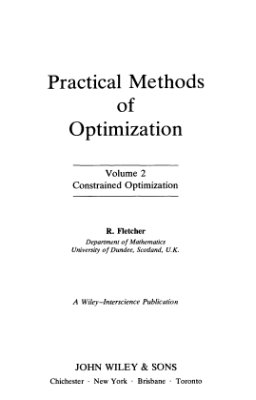John Wiley & Sons, 1981. - 234 Pages.
The general presentation of Volume 2 continues those aims which I set out in the preface to Volume 1 and I shall not repeat the comments here. The additional complication of constraints in an optimization problem does make the general level of the material more difficult and I have made some effort to present at least the basic ideas in a straightforward way. In some cases this has led me to first of all present some results in an intuitive way followed by a rigorous but more mathematical derivation. The chapters in Volume 2 number on from those in Volume 1 so that cross referencing between the volumes is unambiguous. The selection of topics for this volume also has required some thought. Most finite dimensional problems of a continuous nature have been included but I have generally kept away from problems of a discrete or combinatorial nature since they have an entirely different character and the choice of method can be very specialized. In this case the nearest thing to a general purpose method is the branch and bound method, and since this is a transformation to a sequence of continuous problems of the type covered in this volume, I have included a straightforward description of the technique.
The general presentation of Volume 2 continues those aims which I set out in the preface to Volume 1 and I shall not repeat the comments here. The additional complication of constraints in an optimization problem does make the general level of the material more difficult and I have made some effort to present at least the basic ideas in a straightforward way. In some cases this has led me to first of all present some results in an intuitive way followed by a rigorous but more mathematical derivation. The chapters in Volume 2 number on from those in Volume 1 so that cross referencing between the volumes is unambiguous. The selection of topics for this volume also has required some thought. Most finite dimensional problems of a continuous nature have been included but I have generally kept away from problems of a discrete or combinatorial nature since they have an entirely different character and the choice of method can be very specialized. In this case the nearest thing to a general purpose method is the branch and bound method, and since this is a transformation to a sequence of continuous problems of the type covered in this volume, I have included a straightforward description of the technique.

